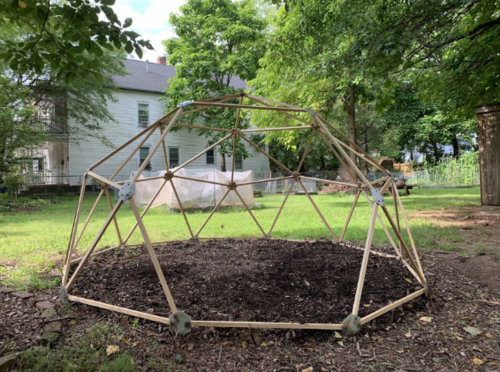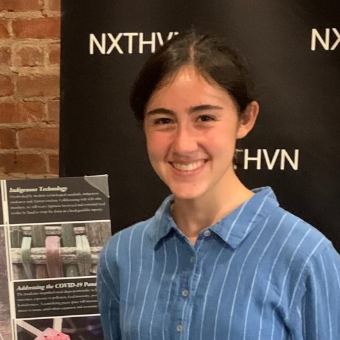
December 18, 2024
Paloma Lenz ‘26 is a junior in Pierson College studying environmental engineering with a concentration in architecture. She enjoys working on collaborative research and design projects and is involved with the Yale Undergraduate Aerospace Association’s Exploration Rover Science Missions System Team, the Elimelech Lab, and MakeHaven. She also works closely with Neighborhood Housing Services of New Haven on collaborative housing projects that incorporate recycled plastic and mycelium-based biomaterial. Paloma loves biking throughout New Haven, practicing the violin, and playing Mario Kart (a little too competitively) with friends. She spoke with Roan Hollander about her Yale Environmental Humanities project– building a geodesic dome in Newhallville.

RH: What is the Geodesic Dome Project?
The Newhallville Geodesic Dome Project (or, more simply known as “the Plastic Dome Project” by some of the Lincoln-Bassett Community School students I’ve presented it to) is an art installation in the Shepard Street Community Garden that attempts to find new purposes for discarded, underused, and unconventional materials. We used polypropylene plastic and two non-native species, Japanese knotweed and Phragmites reeds, as the dome’s base materials. We built the dome in the community garden to spark conversation around the value of alternative plastic use and location-centered design.
What inspired you to take on this project?
Through the Biomimicry Institute’s Biomimicry Launchpad, I met Aspen Decker and Cameron Decker, members and descendants of the Confederated Salish and Kootenai Tribes. Together, they founded Xʷlxʷilt LLC , a business that works to integrate Indigenous culture, art, and language in education. They shared how they used computer-aided design software to model and adapt a traditional Bitterroot digging stick. Since then, I’ve thought about ways of bridging divides between conventional architectural production and the more intimate experience of building with local materials. I imagined a project that would invite collaboration while responding to challenges magnified by the COVID-19 pandemic, namely unequal access to urban green space and health services in the Newhallville neighborhood.
Have you had community partners that have worked with you? What has community engagement been like?
I’ve been working closely with Neighborhood Housing Services of New Haven since my freshman year. After creating a tree identification scavenger hunt, we shifted our attention to the community gardens that NHS helps Newhallville residents run. I met Ms. Addie Kimbrough, who founded the Shepard Street Vegetable Garden where the dome installation is now located.
Can you walk me through what the steps for creating each component of the Dome are?
In addition to the community-building aspect of the project, I’ve also learned technical skills necessary to create the molds for the plastic joints at MakeHaven and the Center for Engineering Innovation and Design. Working with mentors and classmates, I spent the summer creating the beams and joints for the dome. Everyone’s enthusiasm for the dome has been palpable, and I am overjoyed to have met and worked with so many knowledgeable people on this project.
Dome construction begins with the collection of over 6,000 grams of polypropylene plastic (a hefty amount, considering one yogurt cup weighs about 15 grams). As the dome is a hemisphere of a buckyball structure, it’s held together by beams of two distinct lengths connected by either pentagons or hexagons at 108° and 120° angles (intriguing to me as an environmental engineering major with a concentration in architecture). The wooden beams need to be cut and planed to the appropriate length with a table saw and planer. The pentagon and hexagon joints are all injection molded in CNC-machined aluminum molds.
Once all the plastic and wooden parts have been prepared, they are connected by nuts and bolts using a drill or wrench. Most integral to the construction, though, is getting others on board! Whether it was difficulties in editing CAD models, shredding plastic boba cups, or dimensioning wooden beams, multiple project stages required some rerouting. I couldn’t have worked through critical planning stages without technical and community-building support from NHS, classmates, and fellow tinkerers.
What do you hope the Dome will achieve and what are the next steps?
In the process of building the dome, I’ve reflected on the role of community participation in art. The dome is purposefully left to be activated by people who encounter it, so I hesitate to define it with explicit labels. The Salish culture I learned about informs my interpretation of the dome, but for others, it may be little more than a hemispherical structure. The way I see it, public art should receive and celebrate these projections, allowing public opinion to give it shape by remaining ambiguous. And in that way, rather circularly, the dome embodies elements of Indigenous thought by emphasizing how meaning often arises through interaction rather than predefined narratives.
Now that a physical frame has been built, the dome can take on any form that local residents, garden volunteers, and others wish to give it. We plan on creating a thatch cover for the dome using Japanese knotweed and reeds early this spring and are entertaining the idea of creating a greenhouse. Moving forward, I hope to organize more programming around the dome. I’ve shared some of my insights with volunteers and students, many of whom are eager to learn more about the dome’s fabrication.
To encourage future innovation, I also made a digital tutorial about how to make a geodesic dome. You can see more images and footage there from the development of the project. I’ve also offered some further reflections on the project’s origins and development in an extended post and an Instagram profile (@mycoknot_17) to serve as records of the project and lay out a detailed framework for construction. I am beyond excited to encounter others interested in joining the project!
Type:
Public Humanities Grant